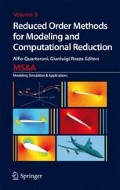Abstract
Proper Orthogonal Decomposition (POD) is a powerful tool for analyzing multidimensional data, especially of vector fields in large-scale simulations. In this article we review the Window Proper Orthogonal Decomposition (WPOD) proposed in [7] for analysis of continuum data and in [5] for analysis of atomistic fields.
Access this chapter
Tax calculation will be finalised at checkout
Purchases are for personal use only
References
Amsallem, D., Zahr, M.J., Farhat, C.: Nonlinear model order reduction based on local reduced-order bases. International Journal for Numerical Methods in Engineering 92(10), 891 (2012)
Deschamps, J., Kantsler, V., Segre, E., Steinberg, V.: Dynamics of a vesicle in general flow. Proc. Natl. Acad. Sci. U.S.A. 106, 11444 (2009)
Espanol, P., Warren, P.: Statistical-mechanics of dissipative particle dynamics. Europhysics Letters 30(4), 191 (1995)
Fedosov, D.A., Caswell, B., Karniadakis, G.E.: A multiscale red blood cell model with accurate mechanics, rheology, and dynamics. Biophys. J. 98(10), 2215 (2010)
Grinberg, L.: Proper orthogonal decomposition of atomistic flow simulations. Journal of Computational Physics 231(16), 5542–5556 (2012)
Grinberg, L., Fedosov, D.A., Karniadakis, G.E.: Proper orthogonal decomposition of atomistic flow simulations. Journal of Computational Physics (2012). doi 10.1016/j.jcp. 2012.08.023
Grinberg, L., Yakhot, A., Karniadakis, G.E.: Analyzing transient turbulence in a stenosed carotid artery by proper orthogonal decomposition. Annals of Biomedical Engineering 37(11), 2200 (2009)
Hoogerburgge, P.J., Koelman, J.M.V.A.: Simulating microscopic hydrodynamic phenomena with dissipative particle dynamics. Europhysics Letters 19(3), 155 (1992)
Kantsler, V., Goldstein, R.E.: Fluctuations, dynamics, and the stretch-coil transition of single actin filaments in extensional flows. Phys. Rev. Lett. 108, 038103 (2012)
Kantsler, V., Segre, E., Steinberg, V.: Vesicle dynamics in time-dependent elongation flow: Wrinkling instability. Phys. Rev. Lett. 99, 178102 (2007)
Kantsler, V., Steinberg, V.: Orientation and dynamics of a vesicle in tank-treadingmotion in shear flow. Phys. Rev. Lett. 95, 258101 (2005)
Kantsler, V., Steinberg, V.: Transition to tumbling and two regimes of tumbling motion of a vesicle in shear flow. Phys. Rev. Lett. 96, 036001 (2006)
Karniadakis, G.E., Beskok, A., Aluru, N.: Microflows and Nanoflows: Fundamentals and Simulation, 2nd ed. Springer, New York (2005)
Kefayati, S., Poepping, T.L.: Transitional flow analysis in the carotid artery bifurcation by proper orthogonal decomposition and particle image velocimetry. Medical Engineering and Physics (2012). DOI 10.1016/j.medengphy.2012.08.020
Lei, H., Caswell, B., Karniadakis, G.E.: Direct construction of mesoscopic models from microscopic simulations. Physical Review E 81, 026704 (2010)
Levant, M., Steinberg, V.: Amplification of thermal noise by vesicle dynamics. Phys. Rev. Lett. 109, 268103 (2012)
Manhart, M.: Vortex shedding from a hemisphere in a turbulent boundary layer. Theoretical and Computational Fluid Dynamics 12, 1 (1998)
Sirovich, L.: Turbulence and dynamics of coherent structures: I-iii. Quarterly of Applied Mathematics 45, 561 (1987)
Sherwin, S.J., Blackburn, H.M.: Three-dimensional instabilities of steady and pulsatile axisymmetric stenotic flows. Journal of Fluid Mechanics 533, 297 (2005)
Turitsyn, K., Vergeles, S.S.: Wrinkling of vesicles during transient dynamics in elongational flow. Phys. Rev. Lett. 100, 028103 (2008)
Visual molecular dynamics. http://www.ks.uiuc.edu/Research/vmd
Werder, T., Walther, J., Koumoutsakos, P.: Hybrid atomistic-continuum method for the simulation of dense fluid flows. Journal of Computational Physics 205, 373 (2005)
Author information
Authors and Affiliations
Corresponding author
Editor information
Editors and Affiliations
Rights and permissions
Copyright information
© 2014 Springer International Publishing Switzerland
About this chapter
Cite this chapter
Grinberg, L., Deng, M., Karniadakis, G.E., Yakhot, A. (2014). Window Proper Orthogonal Decomposition: Application to Continuum and Atomistic Data. In: Quarteroni, A., Rozza, G. (eds) Reduced Order Methods for Modeling and Computational Reduction. MS&A - Modeling, Simulation and Applications, vol 9. Springer, Cham. https://doi.org/10.1007/978-3-319-02090-7_10
Download citation
DOI: https://doi.org/10.1007/978-3-319-02090-7_10
Publisher Name: Springer, Cham
Print ISBN: 978-3-319-02089-1
Online ISBN: 978-3-319-02090-7
eBook Packages: Mathematics and StatisticsMathematics and Statistics (R0)

